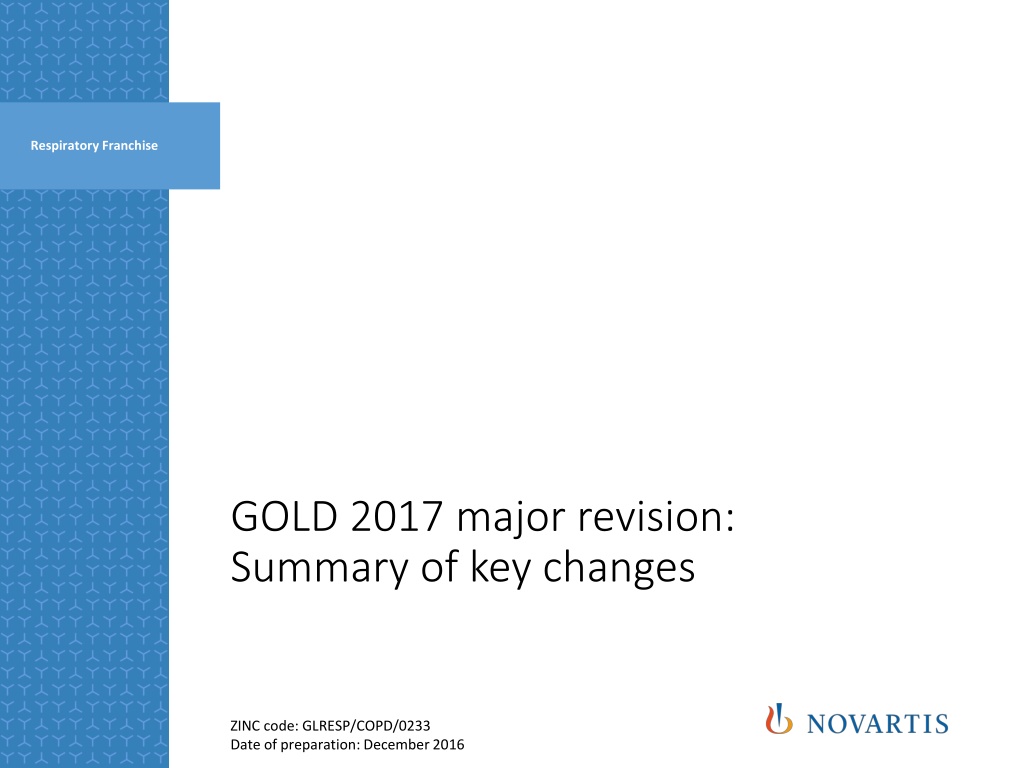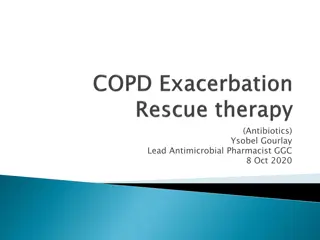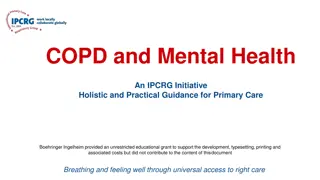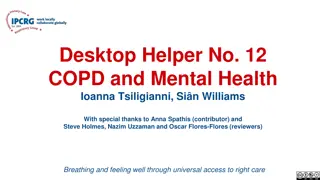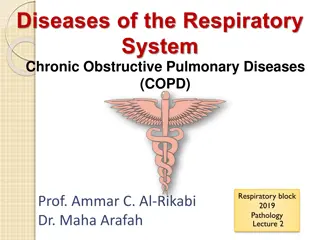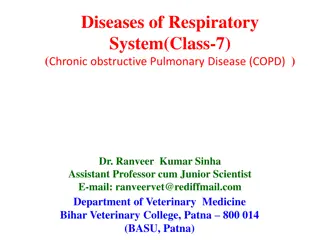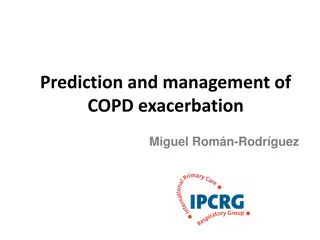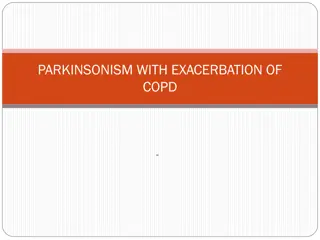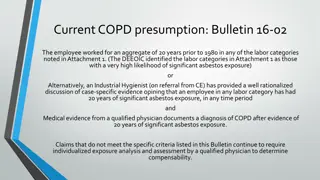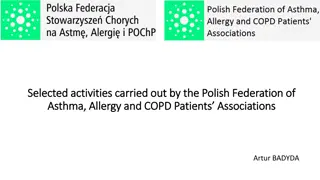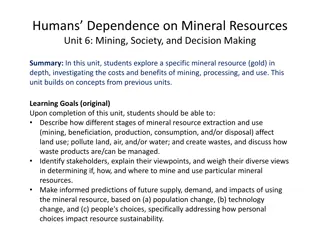GOLD 2017 Major Revisions in COPD Management
GOLD 2017 introduces significant changes in Chronic Obstructive Pulmonary Disease (COPD) management, focusing on areas like defining COPD, assessment tools, pharmacological management, inhaler techniques, and comorbidity management. The updated definition emphasizes persistent respiratory symptoms. Spirometry remains vital for diagnosis, but assessing reversibility is no longer recommended. Treatment decisions should consider symptom assessment and exacerbation risk categorization.
Download Presentation

Please find below an Image/Link to download the presentation.
The content on the website is provided AS IS for your information and personal use only. It may not be sold, licensed, or shared on other websites without obtaining consent from the author.If you encounter any issues during the download, it is possible that the publisher has removed the file from their server.
You are allowed to download the files provided on this website for personal or commercial use, subject to the condition that they are used lawfully. All files are the property of their respective owners.
The content on the website is provided AS IS for your information and personal use only. It may not be sold, licensed, or shared on other websites without obtaining consent from the author.
E N D
Presentation Transcript
Respiratory Franchise GOLD 2017 major revision: Summary of key changes ZINC code: GLRESP/COPD/0233 Date of preparation: December 2016
GOLD 2017 includes major revisions in key areas Key areas of major revision: Definition of COPD ABCD assessment tool Pharmacological management Focus on inhaler technique Management of comorbidities COPD = chronic obstructive pulmonary disease; GOLD = Global Initiative for Chronic Obstructive Lung Disease GOLD 2017
GOLD 2017: Updated COPD definition includes persistent respiratory symptoms GOLD 20161 GOLD 20172 Chronic Obstructive Pulmonary Disease (COPD), a common preventable and treatable disease, is characterized by persistent airflow limitation that is usually progressive and associated with an enhanced chronic inflammatory response in the airways and the lung to noxious particles or gases Chronic Obstructive Pulmonary Disease (COPD) is a common, preventable and treatable disease that is characterized by persistent respiratory symptoms and airflow limitation that is due to airway and/or alveolar abnormalities usually caused by significant exposure to noxious particles or gases 1. GOLD 2016 2. GOLD 2017 COPD = chronic obstructive pulmonary disease; GOLD = Global Initiative for Chronic Obstructive Lung Disease
GOLD 2017: The changing role of spirometry Post-bronchodilator spirometry is required for the diagnosis and assessment of COPD However, assessing the degree of reversibility of airflow limitation (e.g. measuring FEV1 before and after bronchodilator or corticosteroids) to inform therapeutic decisions is no longer recommended Spirometry remains key in the diagnosis, prognostication and treatment with non-pharmacological therapies COPD = chronic obstructive pulmonary disease; FEV1 = forced expiratory volume in 1 second GOLD = Global Initiative for Chronic Obstructive Lung Disease GOLD 2017
GOLD 2017: Symptoms and exacerbation risk should be assessed to determine appropriate treatment 1. Diagnose COPD and determine the severity of airflow limitation (GOLD Grade 1 4) using spirometry 2. Determine GOLD Group (A D) and subsequent appropriate pharmacological treatment by assessing symptoms and exacerbation history (including prior hospitalizations) Spirometrically confirmed diagnosis Assessment of airflow limitation Assessment of symptoms/ risk of exacerbations Exacerbation history FEV1 (% pred.) >2 or 1 leading to hospitalization Grade C D 1 80 Post-bronchodilator FEV1/FVC <0.7 2 50 79 0 or 1 B A (not leading to hospital admission) 3 30 49 4 <30 mMRC 2+ CAT 10+ CCQ 1+ mMRC 0 1 CAT <10 CCQ <1 CAT = COPD Assessment Test; CCQ = Clinical COPD Questionnaire; COPD = chronic obstructive pulmonary disease FEV1 = forced expiratory volume in 1 second; GOLD = Global Initiative for Chronic Obstructive Lung Disease mMRC = modified Medical Research Council GOLD 2017
GOLD 2017: Patient examples using the refined ABCD assessment tool Patient A Patient B FEV1 (% predicted) <30% <30% CAT score 18 18 Exacerbations in the past 12 months 0 3 GOLD 2016 classification D D GOLD 2017 classification1 Group B Group D Removal of FEV1 from the risk assessment may result in more patients being classified as GOLD B than when using previous GOLD criteria More than 50% of patients previously classified as GOLD D (based on airflow limitation alone) may now be classified as GOLD B2 CAT = COPD Assessment Test; FEV1 = forced expiratory volume in 1 second GOLD = Global Initiative for Chronic Obstructive Lung Disease 1. GOLD 2017 2. Agusti A, et al. Eur Respir J 2013
The goals of COPD treatment remain unchanged in GOLD 2017 Relieve symptoms Improve exercise tolerance Improve health status Reduce symptoms Prevent disease progression Prevent and treat exacerbations Reduce mortality Reduce risk COPD = chronic obstructive pulmonary disease; GOLD = Global Initiative for Chronic Obstructive Lung Disease GOLD 2017
GOLD 2017: therapeutic recommendations by GOLD Group Group D Consider roflumilast if FEV1 <50% pred. and patient has chronic bronchitis Group C Consider macrolide LAMA + LABA LABA + ICS Further exacerbation(s) LAMA + LABA + ICS Further Persistent symptoms/further exacerbations exacerbation(s) Further exacerbation(s) LAMA LAMA LAMA + LABA LABA + ICS Group A Group B Continue, stop or try alternative class of bronchodilator LAMA + LABA Persistent symptoms Evaluate effect A long-acting bronchodilator (LABA or LAMA) A bronchodilator FEV1 = forced expiratory volume in 1 second; GOLD = Global Initiative for Chronic Obstructive Lung Disease ICS = inhaled corticosteroid; LABA = long-acting 2-agonist; LAMA = long-acting muscarinic antagonist GOLD 2017
GOLD 2017: Group A patients should be offered either a short- or long-acting bronchodilator A bronchodilator Evaluate effect Continue, stop or try alternative class of bronchodilator Bronchodilator treatment should be continued if symptom benefit is seen GOLD = Global initiative for chronic Obstructive Lung Disease GOLD 2017
GOLD 2017: Group B patients with persistent symptoms should be stepped up to a LABA/LAMA LABA or LAMA Persistent symptoms LABA + LAMA Bronchodilator selection (LABA vs LAMA) in patients with less severe symptoms should depend on the patient s perception of symptom relief Patients with persistent symptoms may be stepped up to LABA/LAMA Patients with severe breathlessness may be started on dual bronchodilation More than 50% of GOLD B patients have CAT scores >20 (high symptom burden),2 and therefore should receive LABA/LAMA as initial therapy, or be stepped up from monotherapy CAT = COPD Assessment Test; GOLD = Global initiative for chronic Obstructive Lung Disease LABA = long-acting 2-agonist; LAMA = long-acting muscarinic antagonist 1. GOLD 2017; 2. Adelphi Respiratory Disease Specific Programme 2016
GOLD 2017: ICS is no longer the preferred choice for patients in GOLD Group C LAMA Preferred choice for persistent exacerbations Alternative LABA + LAMA LABA + ICS Patients with persistent exacerbations may benefit from addition of LABA or a combination of LABA/ICS1 LAMA/LABA is the preferred choice due to pneumonia risk associated with ICS1 - There is also no evidence to suggest superiority of LABA/ICS over LABA/LAMA2 Triple therapy is not recommended1 GOLD = Global initiative for chronic Obstructive Lung Disease; ICS = inhaled corticosteroid LABA = long-acting 2-agonist; LAMA = long-acting muscarinic antagonist 1. GOLD 2017 2.Wedzicha JA, et al. N Engl J Med 2016
GOLD 2017: Dual bronchodilation is the preferred initial therapy for patients in Group D Option for initial therapy in patients with possible ACOS LAMA superior to LABA if single substance selected Recommended initial therapy LAMA LABA + ICS LAMA + LABA Further Further exacerbation(s)/ persistent symptoms exacerbation(s) LABA + LAMA + ICS Further exacerbation(s) Consider roflumilast if FEV1 <50% predicted and patient has chronic bronchitis Consider macrolide ACOS = asthma-COPD overlap syndrome; FEV1 = forced expiratory volume in 1 second GOLD = Global initiative for chronic Obstructive Lung Disease ICS = inhaled corticosteroid LABA = long-acting 2-agonist; LAMA = long-acting muscarinic antagonist GOLD 2017
GOLD 2017: Dual bronchodilation is the preferred initial therapy for patients in Group D GOLD recommends LABA/LAMA as primary-choice treatment for Group D patients1 LABA/LAMA has demonstrated superiority versus bronchodilator monotherapy and LABA/ICS in exacerbation prevention2,3 LABA/ICS may be first choice in patients with a history of and/or features suggestive of asthma-COPD overlap1 Treatment should be escalated to triple therapy in patients who experience further exacerbations despite treatment with LABA/LAMA or LABA/ICS1 - There is currently no evidence to support the efficacy of triple vs LABA/LAMA If further exacerbations develop despite treatment with triple therapy, the addition of a macrolide or roflumilast may be considered1 - - GOLD also suggest the withdrawal of ICS if exacerbations persist on triple therapy FEV1 = forced expiratory volume in 1 second GOLD = Global initiative for chronic Obstructive Lung Disease; ICS = inhaled corticosteroid LABA = long-acting 2-agonist; LAMA = long-acting muscarinic antagonist 1. GOLD 2017 2. Wedzicha JA, et al. Lancet Respir Med 2013 3. Wedzicha JA, et al. N Engl J Med 2016
GOLD 2017 emphasizes the importance of proper inhaler technique Inhaler technique should be assessed regularly Determinants of poor inhaler technique in asthma and COPD patients include: - Older age - Use of multiple devices - Lack of previous education on inhaler technique Providing patients with quality education regarding proper inhaler technique is important COPD = chronic obstructive pulmonary disease; GOLD = Global initiative for chronic Obstructive Lung Disease GOLD 2017
GOLD 2017: Identifying and treating comorbidities is important in patients with COPD COPD often coexists with other diseases that may have a significant impact on health status and prognosis Cardiovascular disease is a major comorbidity in COPD Probably the most frequent and most important comorbid disease Other common comorbidities include skeletal muscle dysfunction, metabolic syndrome, osteoporosis, depression, anxiety and lung cancer Comorbidities should be actively sought and treated appropriately COPD = chronic obstructive pulmonary disease; GOLD = Global initiative for chronic Obstructive Lung Disease GOLD 2017
Summary: GOLD 2017 includes major revisions in key areas Definition of COPD Refined to place more emphasis on symptoms and comorbidities ABCD assessment tool Refined to assess both symptom level and risk of future exacerbations following the revised role of spirometry in COPD Pharmacological management Pharmacological algorithms added Dual bronchodilation recommended as a first-line therapy for a majority of symptomatic patients ICS therapy only recommended in a minority of patients as an alternative to preferred LABA/LAMA treatment Focus on inhaler technique Emphasizes the importance of patient education Management of comorbidities Emphasizes the importance of identifying and treating comorbidities COPD = chronic obstructive pulmonary disease; GOLD = Global Initiative for Chronic Obstructive Lung Disease LABA = long-acting 2-agonist; LAMA = long-acting muscarinic antagonist GOLD 2017
